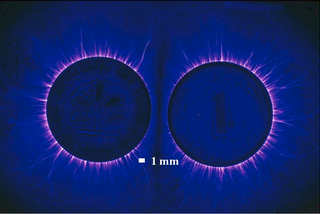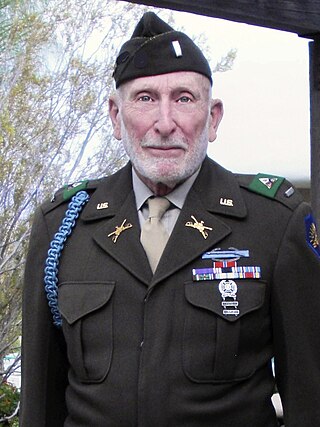Related Research Articles

Kirlian photography is a collection of photographic techniques used to capture the phenomenon of electrical coronal discharges. It is named after Soviet scientist Semyon Kirlian, who, in 1939, accidentally discovered that if an object on a photographic plate is connected to a high-voltage source, an image is produced on the photographic plate. The technique has been variously known as "electrography", "electrophotography", "corona discharge photography" (CDP), "bioelectrography", "gas discharge visualization (GDV)", "electrophotonic imaging (EPI)", and, in Russian literature, "Kirlianography".

Reverse Polish notation (RPN), also known as reverse Łukasiewicz notation, Polish postfix notation or simply postfix notation, is a mathematical notation in which operators follow their operands, in contrast to prefix or Polish notation (PN), in which operators precede their operands. The notation does not need any parentheses for as long as each operator has a fixed number of operands.
Control Data Corporation (CDC) was a mainframe and supercomputer company that in the 1960s was one of the nine major U.S. computer companies, which group included IBM, the Burroughs Corporation, and the Digital Equipment Corporation (DEC), the NCR Corporation (NCR), General Electric, and Honeywell, RCA and UNIVAC. For most of the 1960s, the strength of CDC was the work of the electrical engineer Seymour Cray who developed a series of fast computers, then considered the fastest computing machines in the world; in the 1970s, Cray left the Control Data Corporation and founded Cray Research (CRI) to design and make supercomputers. In 1988, after much financial loss, the Control Data Corporation began withdrawing from making computers and sold the affiliated companies of CDC; in 1992, CDC established Control Data Systems, Inc. The remaining affiliate companies of CDC currently do business as the software company Dayforce.

Engineering Research Associates, commonly known as ERA, was a pioneering computer firm from the 1950s. ERA became famous for their numerical computers, but as the market expanded they became better known for their drum memory systems. They were eventually purchased by Remington Rand and merged into their UNIVAC department. Many of the company founders later left to form Control Data Corporation.

UNIVAC was a line of electronic digital stored-program computers starting with the products of the Eckert–Mauchly Computer Corporation. Later the name was applied to a division of the Remington Rand company and successor organizations.
Bullet time is a visual effect or visual impression of detaching the time and space of a camera from that of its visible subject. It is a depth enhanced simulation of variable-speed action and performance found in films, broadcast advertisements, and realtime graphics within video games and other special media. It is characterized by its extreme transformation of both time, and of space. This is almost impossible with conventional slow motion, as the physical camera would have to move implausibly fast; the concept implies that only a "virtual camera", often illustrated within the confines of a computer-generated environment such as a virtual world or virtual reality, would be capable of "filming" bullet-time types of moments. Technical and historical variations of this effect have been referred to as time slicing, view morphing, temps mort and virtual cinematography.

In photography, reversal film or slide film is a type of photographic film that produces a positive image on a transparent base. Instead of negatives and prints, reversal film is processed to produce transparencies or diapositives. Reversal film is produced in various sizes, from 35 mm to roll film to 8×10 inch sheet film.

A mechanical calculator, or calculating machine, is a mechanical device used to perform the basic operations of arithmetic automatically, or (historically) a simulation such as an analog computer or a slide rule. Most mechanical calculators were comparable in size to small desktop computers and have been rendered obsolete by the advent of the electronic calculator and the digital computer.

The Norden Mk. XV, known as the Norden M series in U.S. Army service, is a bombsight that was used by the United States Army Air Forces (USAAF) and the United States Navy during World War II, and the United States Air Force in the Korean and the Vietnam Wars. It was an early tachometric design, which combined optics, a mechanical computer, and an autopilot for the first time to not merely identify a target but fly the airplane to it. The bombsight directly measured the aircraft's ground speed and direction, which older types could only estimate with lengthy manual procedures. The Norden further improved on older designs by using an analog computer that continuously recalculated the bomb's impact point based on changing flight conditions, and an autopilot that reacted quickly and accurately to changes in the wind or other effects.
Max Palevsky was an American art collector, venture capitalist, philanthropist, and computer technology pioneer. He was known as a member of the Malibu Mafia – a group of wealthy American Jewish men who donated money to liberal and progressive causes and politicians.
The Eckert–Mauchly Computer Corporation (EMCC) was a computer company founded by J. Presper Eckert and John Mauchly. It was incorporated on December 22, 1947. After building the ENIAC at the University of Pennsylvania, Eckert and Mauchly formed EMCC to build new computer designs for commercial and military applications. The company was initially called the Electronic Control Company, changing its name to Eckert–Mauchly Computer Corporation when it was incorporated. In 1950, the company was sold to Remington Rand, which later merged with Sperry Corporation to become Sperry Rand, and survives today as Unisys.
Bernard S. Benson was a British inventor and author.

Mitchell Camera Corporation was an American motion picture camera manufacturing company established in Los Angeles in 1919. It was a primary supplier of newsreel and movie cameras for decades, until its closure in 1979.

The Marchant Calculating Machine Company was founded in 1911 by Rodney and Alfred Marchant in Oakland, California.
Honeywell, Inc. v. Sperry Rand Corp., et al., 180 U.S.P.Q. 673, was a landmark U.S. federal court case that in October 1973 invalidated the 1964 patent for the ENIAC, the world's first general-purpose electronic digital computer. The decision held, in part, the following: 1. that the ENIAC inventors had derived the subject matter of the electronic digital computer from the Atanasoff–Berry computer (ABC), prototyped in 1939 by John Atanasoff and Clifford Berry, 2. that Atanasoff should have legal recognition as the inventor of the first electronic digital computer and 3. that the invention of the electronic digital computer ought to be placed in the public domain.

Wirgin was a German company which is still known for its brands Wirgin and Edixa, and for its camera types like the Edina, the Edinex or the Gewirette. It was based in the Hessian capital Wiesbaden and made a line of quite inexpensive 35mm SLRs from the 1950s to the 1970s, including the Edixa Reflex and Edixa-Mat Reflex. Wirgin was West Germany's main producer of SLRs with focal plane shutter. It also produced some of the lenses for its cameras, among them several M42 screw mount lenses.

The MADDIDA was a special-purpose digital computer used for solving systems of ordinary differential equations. It was the first computer to represent bits using voltage levels and whose entire logic was specified in Boolean algebra. Invented by Floyd Steele, MADDIDA was developed at Northrop Aircraft Corporation between 1946 and 1949 to be used as a guidance system for the Snark missile. No guidance system, however, resulted from the work on the MADDIDA, and rather it was used for aeronautical research. In 1952, the MADDIDA became the world's top-selling commercial digital computer, six units having been sold.

Donald B. Prell was an American World War II veteran, venture capitalist and futurist who created Datamation, the first magazine devoted solely to the computer hardware and software industry.
Packard Bell Corporation was an American electronics manufacturer founded in 1933 by Herb Bell and Leon Packard. Initially they produced radios, but expanded into defense electronics during World War II. After the war, they began manufacturing other consumer electronics, including television sets. In 1957, the company became involved in the manufacture of scientific and military computers. Industrial conglomerate Teledyne Technologies acquired the business in 1968. In 1986, Israeli investors bought the name for a newly formed personal computer manufacturer, Packard Bell.
The PB 250 was a general-purpose computer introduced in 1960 by the Packard Bell Corporation.
References
- ↑ "Friden EC-130 Electronic Calculator". www.oldcalculatormuseum.com.
- 1 2 3 4 5 6 7 8 9 10 11 "Oral history interview with George M. Ryan" (PDF) (Interview). Charles Babbage Institute, University of Minnesota.
- ↑ Ampex Corp. (November 1964). "Shortest distance between two points...SAVES COMPUTER TIME" (PDF). www.bitsavers.org. Datamation Magazine. p. 37.
- ↑ Computer History Museum. Benson-Lehner Corporation. July 1967.
- ↑ Bensene, Rick (8 September 2020). "Friden EC-130 Electronic Calculator". The Old Calculator Web Museum.
- 1 2 "Guy H. Hearon Dies at 99". Bonner County Daily Bee. 8 February 2023. Retrieved 5 February 2024.
- ↑ BENSON, BERNARD S. (1 October 1981). "The Peace Book" (PDF). www.peacechildthemusical.com. ISBN 978-0224019897.
- ↑ "UCLA Today - In Memorium". www.newmediawire.com. 20 March 2007.
- ↑ "In Memoriam of W. Edgar Jessup, Jr., Founding Partner". Ervin Cohen & Jessup LLP. 7 February 2024.
- ↑ Sanderson, Matthew (21 November 2013). "Beverly Hills Law Firm Celebrates 60 Years". www.patch.com.
- ↑ "Securities and Exchange Commission News Digest" (PDF). Securities and Exchange Commission. 5 May 1959.
- ↑ Church, Thomas D (1952). "Sperry (Leonard M.) Residence, Los Angeles, CA, 1952-1953". Calisphere University of California. UC Berkeley, Environmental Design Archives. Retrieved 2 February 2024.
- ↑ "Mrs. Leonard M. Sperry; Founded Center in Rome". The New York Times. 31 July 1972. Retrieved 2023-05-25.
- ↑ Leovy, Jennifer (2000-07-13). "Pledge of $20 million from Max Palevsky to enhance residential life". The University of Chicago Chronicle. Retrieved 2006-05-23.
- ↑ Grimes, William (7 May 2010). "Max Palevsky, a Pioneer in Computers, Dies at 85". The New York Times. Retrieved 2023-05-25.
- ↑ Woo, Elaine (6 May 2010). "Max Palevsky dies at 85; computer magnate and philanthropist". Los Angeles Times. Retrieved 2023-05-25.
- ↑ Dore, Shalini (6 May 2010). "Tech pioneer Max Palevsky dies". Variety. Retrieved 2023-05-25.
- ↑ "Congress Session Chairmen and Vice-Chairmen". Journal of the SMPTE. 71 (1A). Society of Motion Picture and Television Engineers: ix. 1962. doi:10.5594/J18202. ISSN 0361-4573.
- ↑ Franck Delage (5 September 1964). "UGC Instruments And Benson-Lehner Unit". NY Times. Retrieved 7 February 2024.
- ↑ "Tibetan Buddhism in the Dordogne, a brief history". www.dechenjournal.com. Dechen Journal. 24 August 2018. Retrieved 7 February 2024.